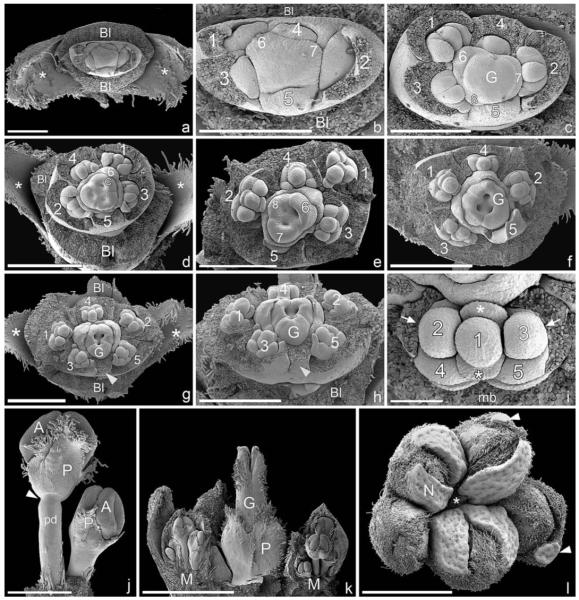Fig. 8.
Ontogeny of pseudanthium in Anthostema madagascariense (SEM). (a) Young pseudanthium preceded by two median bracteoles, flanked by two further transversal prophylls (asterisks). (b) Helical formation of four male inflorescences in the axils of bracts (1–4). The fifth bract becomes part of the perianth of the central female flower. The remaining two perianth parts of the female flower are also formed in succession, following the spiral of the male inflorescences (5–7). (c) Somewhat older developmental stage, showing a similar condition as in (a), except that all three perianth parts of the female flower formed separately and in addition to the fifth bract (5) of the male inflorescence “whorl.” The gynoecium has begun to differentiate. (d) Pseudanthium preceded by two transversal bracteoles (Bl; adaxial/upper bracteole only partly visible to the left) and by two further lateral prophylls (asterisks). Five male inflorescences have formed in a spiral (1–5). The fifth inflorescence in an abaxial position remains small or rudimentary. The gynoecium/female flower is preceded by a single larger organ (6), which is in a position following the spiral of the male inflorescences. The rest of the perianth forms a more or less uniform ringlike structure. The three carpels of the syncarpous gynoecium are visible (one labeled C). (e) Five male elements formed in a spiral (1–5), the first one lying somewhat off the “male whorl” and the fifth one small or reduced. Similar to (d), the formation of the first female tepal follows the male spiral, and even the three carpels show a distinct developmental gradation (6–8) but in reverse direction of the male spiral. (f) Only four male inflorescences have formed. The position of the potential fifth male inflorescence is filled with a larger structure belonging to the perianth of the female flower. (g) Similar developmental stage to (f), but with five male inflorescences. The female tepal in an abaxial/lower position has been removed and seems to be part of the male inflorescence “whorl” (arrowhead). (h) Abaxial view of (g) showing insertion of tepal in a position where the other male inflorescences have formed (arrowhead). (i) Male inflorescence subtended by male bract. A central flower is formed first (1) and preceded by two lobes in median position, which later form the perianth (asterisks). Flowers 2 and 3 arise in transversal position, each subtended by a bract (arrow). Flowers 4 and 5 are initiated in abaxial position. (j) Male flowers with anthers partly enclosed by perianth. The constriction is present in the left flower (arrowhead), while the right flower has no sign of a constriction yet. Note the similarity with male flowers of Dichostemma glaucescens (Fig. 7a–d). (k) Longisection of pseudanthium with central female flower flanked by two male inflorescences. The female flower consists of a trimerous gynoecium basally enclosed by a perianth. (l) Frontal view of pseudanthium in which the central female flower is reduced (asterisk). Note the distinct nectaries (one marked with N) along the rims of the male bracts. Two nectaries are distinctly smaller (arrowheads). Bar = 300 μm in a–c; 500 μm in d–h, j–l; 100 μm in i. A, anther; C, carpel; Bl, bracteole; G, gynoecium; mb, male bract; N, nectar gland; P, perianth; pd, pedicel.

